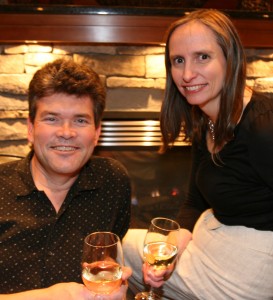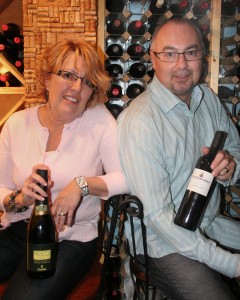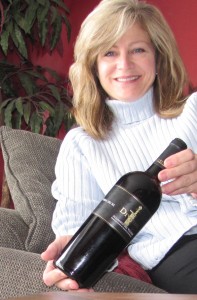 One last bit of writing from the spring issues of Fine Lifestyles Regina and Fine Lifestyles Saskatoon, as the release of the summer issues approaches. Here’s “The Willetts on Wine,” the wine column I write with my wife, Margaret Anne…
One last bit of writing from the spring issues of Fine Lifestyles Regina and Fine Lifestyles Saskatoon, as the release of the summer issues approaches. Here’s “The Willetts on Wine,” the wine column I write with my wife, Margaret Anne…
***
When you go into the liquor store, you’re faced with a bewildering selection of wines. So many bottles, so many possibilities. How do you choose a good one?
You could judge the wine by its label, of course, and many do. Which is why wineries try so hard (sometimes a little too hard, if you ask us: Fat Bastard, anyone?) to come up with unique names for their wines, and labels that will stand out on the shelf.
Still, you can put any old plonk in a fancy bottle with a beautiful label, and the wine will still be bad. So how do you get beyond appearances and figure out what to drink when you yourself haven’t tasted a wine?
If you’re knowledgeable enough, you probably already have some idea of what to expect from a given bottle based on its country of origin, the varietal, and the reputation of the winery. But even that can be a moving target as, vintage to vintage, grape-growing conditions vary.
What you really need is advice. And that’s where wine-rating systems come in…
…but guess what? There’s more than one of those, too. Whose ratings do you trust?
Putting the systems to the test
The best way to find out is to take a wine that you already know well, and love, and compare your tasting of it to the reviewers’ take. (Or, alternatively, you could use a wine that you loathe, but it seems a bit masochistic to drink a wine you really hate just to find out if the wine reviewers hate it, too!).
With that in mind, we thought it would be interesting to look at various systems with respect to one of our go-to family dinner wines, Wyndham Shiraz Bin 555.
One rating system you’ll see everywhere is the 100-point system made popular by guru Robert Parker of The Wine Advocate. Similar systems are used by other publications, such Wine Spectator. Scores in this point system are frequently displayed in liquor stores to help you make an informed decision…or at least to encourage you to buy certain wines!
Introduced by Parker in 1978, the strength of these 100-point systems lies in the universal understanding of what a high percentage means. (Although, ironically, Robert Parker never rates a wine below 50 points, so is it really a 100-point system, or…?)
Our Wyndham Shiraz Bin 555 (at least the 2005 vintage) was rated 88/100 by Wine Spectator and, by way of comparison, 91/100 by Australian Gourmet Traveller Wine (um, who?).
But when was the last time you saw a wine rated 23, or even 61? In fact, you never seem to see wines rated below 80…which makes the 100-point system more like a 20-point system.
That being the case, why not use a 20-point system?
The U.C. Davis system
That’s what we usually use when we rate wines ourselves. The one we like was developed by the University of California Davis, the hot-bed of viticultural study and research. It’s been around for a long time: it was established in 1959 to give the university a way to rate the large number of experimental wines produced there.
The simple and straightforward U.C. Davis system allows you to rate the wine based on 10 basic characteristics: appearance, colour, aroma and bouquet, volatile acidity, total acidity, sweetness/sugar, body, flavour, astringency and general quality. A rating of 17 to 20 indicates a wine of outstanding characteristics having no defects; 13 to 16 indicates a standard wine with neither outstanding character or defect; nine to 12 indicates a wine of commercial acceptability with noticeable defects, five to eight indicates a wine below commercial acceptability, and one to five would mean a completely spoiled wine.
Putting our standby wine to the U.C. Davis test gives us a score of 16—right at the top of “a standard wine with neither outstanding character or defect,” which sounds just about right.
There are other rating systems out there as well, all of which can help you choose a good bottle of wine—especially if you put them to the test and find the ones where the assigned ratings match up to your personal taste.
Ultimately, though, all you really need is a two-point system: either you will buy the wine again, or you won’t.
When it comes to the Wyndham Shiraz Bin 555, that one’s easy: yes, we will!
Our readers recommend…
Neil McClughan
Pirramimma Petit Verdot
A favourite wine? What if I don’t have one? Life is too short to limit your wine experience to a handful of wines. For reds, I tend to gravitate to bigger, bolder wines, especially those that are unique in some way or from smaller boutique producers. One example is Pirramimma from the McLaren Vale region of Australia, made from 100-percent Petit Verdot. Petit Verdot is one of the five Bordeaux classic red grapes, though it is seldom used in Bordeaux anymore since it is extremely late-ripening and often subject to frost. However, in Australia it thrives. The Pirramimma Petit Verdot is a huge wine and can be quite overpowering when opened. Give it a few minutes in the glass to breathe, and it will change immensely. It’s great with stronger cheeses or with rich-flavoured braised meats.
Prosecco Di Conegliano
I was introduced to Prosecco 18 years ago and loved it! It is great to see North America picking up on the European trend of this refreshing light sparkling (frizzante) wine with biscuit-like notes. As sparkling wines go, Italian Proseccos range from very dry to slightly sweet, usually with small persistent bubbles. The cheaper ones can be a bit harsher. It is a great aperitif and is wonderful for any occasion, with any food. Prosecco is also great for making Bellini cocktails. The name is derived from the Veneto-region Italian village where the grape is believed to have originated. One great example available at SLGA stores is Prosecco Di Conegliano by Canella. A regular staple in our cellar as is Villa di Maser Prosecco, available through the Saskatchewan Opimian Wine Society.
Ellen and Neil McClughan (Level 2 Certificate from the International Sommelier Guild) are past Opimian Society representatives for South Saskatchewan. Ellen is a Systems Administrator and Neil is a co-owner of Tice Consulting Inc., a Business and Strategic IT Management Consulting firm. They love gourmet food, meeting fellow wine lovers, and practicing wine sampling as often as possible.
Divinus 2005
Aglianico del Vulture DOC
Recently, my partner Brad chose Divinus for me for a blind tasting at home—what a choice! I was intrigued by the lush, deep garnet colour and aromas of chocolate, leather and tobacco. Smooth and dense, the taste was equally intriguing, with flavours of dark fruit, sour cherry, cocoa, vanilla and spice. I was almost certain this was a blend. But in fact, Divinus is a varietal, produced from Italian aglianico (ah-LEE-AH-nee-koe) grapes. I enjoyed it on its own, but I wouldn’t hesitate to serve Divinus with red-meat dishes, cheeses and more. You can find this divine wine at Saskatoon’s new private wine shop, Cava Wines & Spirits (at River Landing near the Farmer’s Market).
Sharon is an enthusiast and student of wine and a communications professional at the University of Saskatchewan.









